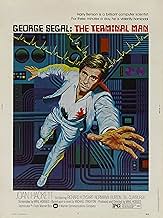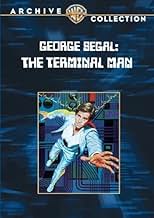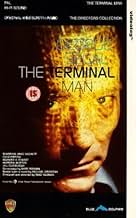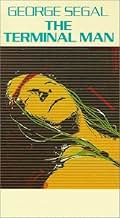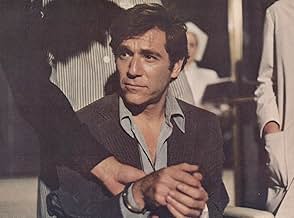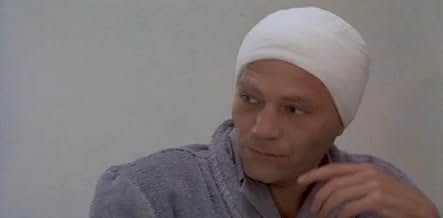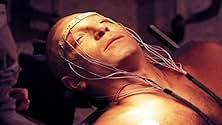Ajouter une intrigue dans votre langueHoping to cure his blackout seizures which turn him temporarily extremely violent, a computer scientist agrees to an experimental brain computer chip implant surgery.Hoping to cure his blackout seizures which turn him temporarily extremely violent, a computer scientist agrees to an experimental brain computer chip implant surgery.Hoping to cure his blackout seizures which turn him temporarily extremely violent, a computer scientist agrees to an experimental brain computer chip implant surgery.
- Réalisation
- Scénario
- Casting principal
- Dr. John Ellis
- (as Richard A. Dysart)
- Det. Capt. Anders
- (as Normann Burton)
Avis à la une
George Segal is believable as Harry, and the rest of the cast is fine, and though Mike Hodges tries, this film is simply too dreary and downbeat to succeed, and by the end, there doesn't seem to have been any discernible point to it all.
That's one thing you need to know going in. The other is not that it's slow, but that it spends a ridiculous amount of time on the fictitious surgery. For example, the doctor almost hits a vein in the patient's brain which would have killed him. However, a surgical mistake can happen in any sort of surgery and this lengthy bit doesn't address the far more interesting ethical issues.
This is in contrast to The Andromeda Strain. In that film, there are enormously detailed and lengthy scenes of the Wildfire lab. But the difference is that movie was more about the scientists and the lab than the germ itself. Here, that's just not the case.
There's other parts of the film that provide a weird atmosphere yet seem entirely irrelevant. The doctor goes to a strip club to find Segal and while I like the music played, it's hard to see why this is here considering it's mostly focused on the stripper stage.
The far more interesting issues are of course the ethical ones.
The treatment they give this man is directly compared to lobotomies, a very dark page of medical history. After they install the device, they start activating different electrodes to see what happens... this isn't that much different than the lobotomy performed on Rosemary Kennedy where they kept cutting while talking to her to see the effects. It's incredibly chilling and plausible.
A curiosity here is that there is essentially an ad for Scientology on the radio in the background in one scene. This makes sense considering their disdain for psychiatry which was rather well founded at least at the time.
There's frustration here in that one huge theme seems to have been all but ignored-- that the patient was convinced computers would take over. I suppose the idea might have been that Segal was increasingly acting robotic... in several scenes when he's walking he does seem like a mindless drone. But I just saw him as a zonked out zombie and zombies are standard horror fare. It didn't occur to me that that might have been the idea until I was writing this review.
Anyway, it's a fascinating watch as long as you know what you're getting into. It's definitely NOT a thriller. There are many striking visuals, like a long curious zoom on a parrot.
I urge anyone with an IQ larger than their shoe size to ignore the negative comments and give this film a chance. Viewed with an open mind and a little patience, this movie becomes quite an exiting experience. It's one of the greatest sci-fi/horror films of all time, and has never gotten its due respect. It's the kind of film we could use more of, and the fact it's considered boring by today's audiences is very sad proof of the dumbing-down effect of Hollywood clap-trap. We're used to movies that ask you to set back while you're force-fed the story. The Terminal Man requires that you watch what's happening, listen to what's being said, and think about what's between the lines. If you can't do that, stick with Vin Diesel films.
The plot centres on a group of scientists and doctors who are pushing the frontiers of neuroscience by implanting a computerized chip in the brain of a man (George Segal) afflicted with terrible seizures. The chip is programmed to shock the patient's brain each time a seizure is about to happen. The effort is prestigious, the technology flawless, and the doctors, scientists and technicians react to the initial success of the project with a certain conceited arrogance. Only when the the chip malfunctions, and the patient breaks out of the hospital and starts killing people, does the veneer of omnipotence and professionalism fall away, revealing in the scientists ambition, uncertainty, and humanity.
Segal does a good job of portraying the wildly changing emotions of a man who's mind is under the control of a computer. At the push of a button he can be made to laugh, cry, scream, babble like a child, or even become aroused, as the computer chip in his brain explores his mental map. It's a study that would be interesting to fans of Oliver Sacks.
The most interesting moments of the movie are the early ones, where the patient interacts with his dispassionate doctors in the sterile, streamlined chromium world of the hospital. The doctors and scientists seem like mechanical, perfected reflections of the technologies that surround them. The messy humanity of the patient, demonstrated through humour, fear, weakness and anger, stands in contrast to his surroundings, and it is not surprising to the audience when he disappears from his hospital room.
Scenes of the doctors in tuxedos and evening gowns at a dinner party while a shiny computer console monitors their ailing patient lend the robotic professionals a strange, formal humanity, at the same moment in the movie when their own fallibility begins to be revealed. Both technology and technologists promise perfection, and in the end both are revealed as imperfect and unable to overcome the challenges of the human condition - sickness, insanity, violence and death.
Once the patient leaves the hospital, the movie shifts to a more conventional 'crazed murderer' theme, and things become less interesting. It is this shift that cripples Terminal Man and prevents it from being the science fiction classic it might have been. The movie closes with a disappointing, clichéd 'Big Brother' riff on mind control and the future.
This is still a movie worth watching, however, if only to get a glimpse of how the 1970s saw the near future. There are endless details for the technophile, from absurdly technological architecture to atomic batteries to ancient video terminals to mainframe computers to futuristic touchtone telephones. The technological landscape is presented with a glistening newness that evokes movies like The Anderson Tapes, Coma, Westworld, and The Andromeda Strain (the last three of which, like Terminal Man, were written by Michael Crichton). The set design and the soundtrack (mostly Bach, No. 25 in the Goldberg Variations) create an inviting, peaceful sense of space that stands at odds with the tension of the plot. The clean, elegant world of Terminal Man is one in which you would want to live.
Watch Terminal Man for the sets, for the music, and for its nostalgic sense of a forgotten future. Back in the 70s, this was the future everyone was expecting, if not hoping to find right around the corner. Like Andromeda Strain, Coma and the Anderson Tapes, Terminal Man is less a thriller and more a cultural time capsule. Get comfortable in your beanbag chair, turn on the lava lamp, and enjoy.
Le saviez-vous
- AnecdotesCrichton was fired from writing the screenplay due to the fact that his script did not follow the novel (which he had written) closely enough.
- GaffesAt the cemetery, the usual mechanism for lowering the coffin into the grave is missing. There aren't even any straps in place to lower it manually.
- Citations
Benson: [mumbles]
Dr. John Ellis: [operating on Benson] What was that?
Dr. Robert Morris: Patient.
Dr. John Ellis: You all right, Mr. Benson?
Benson: [groggily] Fine... fine...
Dr. John Ellis: Any pain?
Benson: No...
Dr. John Ellis: Good. Just relax now.
Benson: You too doctor...
- Versions alternativesOn its release at 2003 Edinburgh Film Festival, there was a director's cut which Hodges had cut out the beginning with the doctor looking at photographs of Harry Benson.
- ConnexionsFeatured in Cinemacabre TV Trailers (1993)
- Bandes originalesGoldberg Variation No. 25
by Johann Sebastian Bach (as J.S. Bach)
Played by Glenn Gould
Courtesy Columbia Records
Meilleurs choix
- How long is The Terminal Man?Alimenté par Alexa
Détails
- Date de sortie
- Pays d’origine
- Langue
- Aussi connu sous le nom de
- El hombre terminal
- Lieux de tournage
- Société de production
- Voir plus de crédits d'entreprise sur IMDbPro
Box-office
- Montant brut aux États-Unis et au Canada
- 224 542 $US
- Durée1 heure 44 minutes
- Mixage
- Rapport de forme
- 1.85 : 1
Contribuer à cette page



